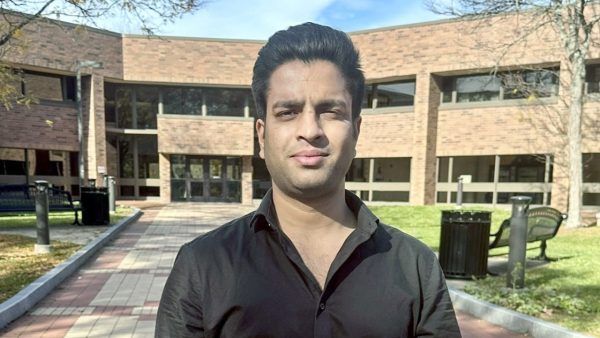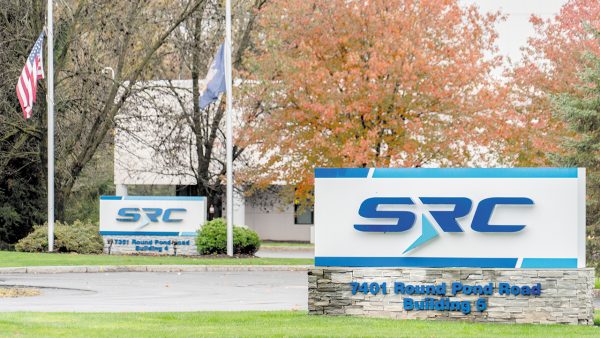Get our email updates
Stay up-to-date on the companies, people and issues that impact businesses in Syracuse, Central New York and beyond.
What's New
Upcoming Events
CNYBJ Job Board

PAR Technology debuts Coach AI, first product in its new PAR AI intelligence suite
NEW HARTFORD, N.Y. — PAR Technology Corp. (NYSE: PAR) says it has launched PAR AI, the new intelligence layer embedded directly into the PAR product

Former Syracuse basketball star Tiana Mangakahia dies after battle with cancer at age 30
SYRACUSE, N.Y. — Tiana Mangakahia, a star guard for the Syracuse University (SU) women’s basketball team from 2017-2021, died Thursday after a battle with cancer

The Everson Museum of Art has announced the appointment of Taylor Arras as director of development. She brings more than a decade of experience in

The Everson Museum of Art has announced the appointment of Kaziah Searles as director of marketing and communications. She brings more than a decade of

Work on CCE expansion in Oriskany to continue through next fall
ORISKANY, N.Y. — Work is underway on a $7.2 million expansion project that will add 16,000 square feet of office, conference, and support space to

New executive director settles in at Naturally Lewis
LOWVILLE, N.Y. — The new executive director of Naturally Lewis, Inc. has been on the job for more than a month, leading the Lewis County–based nonprofit economic-development organization. Joanne Witt officially started work on Monday, Aug. 4, succeeding Brittany Davis in the role. Before joining Naturally Lewis, Witt most recently served as director of the
Get Instant Access to This Article
Become a Central New York Business Journal subscriber and get immediate access to all of our subscriber-only content and much more.
- Critical Central New York business news and analysis updated daily.
- Immediate access to all subscriber-only content on our website.
- Get a year’s worth of the Print Edition of The Central New York Business Journal.
- Special Feature Publications such as the Book of Lists and Revitalize Greater Binghamton, Mohawk Valley, and Syracuse Magazines
Click here to purchase a paywall bypass link for this article.
LOWVILLE, N.Y. — The new executive director of Naturally Lewis, Inc. has been on the job for more than a month, leading the Lewis County–based nonprofit economic-development organization.
Joanne Witt officially started work on Monday, Aug. 4, succeeding Brittany Davis in the role. Before joining Naturally Lewis, Witt most recently served as director of the STARBASE Fort Drum Academy for the past three years, according to her LinkedIn profile.
“I am thrilled to be joining the Naturally Lewis Team as the Executive Director and serving our community in this new role,” Witt said in the Naturally Lewis announcement.
This transition follows the planned departure of Davis. She is now working as a consultant and facilitator for Focus Consulting in Carthage, according to her LinkedIn profile. Naturally Lewis says it is grateful for her years of dedication, leadership, and vision for “impactful and intentional” economic development. Davis worked for the organization for more than nine years,
The Naturally Lewis board of directors led an “extensive and competitive” hiring process to identify the organization’s next executive director. The position’s responsibilities include organizational leadership and strategic planning, staff leadership and development, economic and business development, community engagement and partnerships, and financial and operations management.
“Naturally Lewis, Inc. is proud to announce Joanne Witt as the Executive Director of our organization,” Mike Jackson, board chairman, said. “With a strong background in education and youth development, Joanne brings a fresh perspective to the work of community and economic development. Her passion for empowering people and building connections will be an incredible asset as we continue to grow and serve Lewis County.”
Witt also previously worked in positions at Jefferson-Lewis BOCES, St. Lawrence Lewis BOCES, and Watertown City School District, per her LinkedIn.
Naturally Lewis, based in Lowville, says it focuses on business development and support services, tourism development, property, and site development, and sustaining economic development in its communities.

20 finalists named for $3 million Grow-NY competition
ITHACA, N.Y. — The companies Seen Nutrition of Ithaca and Renewal Mill of Canandaigua are among the 20 finalists in the 7th round of the Grow-NY food and agriculture business competition that annually awards $3 million in prize money. The finalists also include four companies from New York City and international businesses that include two
Get Instant Access to This Article
Become a Central New York Business Journal subscriber and get immediate access to all of our subscriber-only content and much more.
- Critical Central New York business news and analysis updated daily.
- Immediate access to all subscriber-only content on our website.
- Get a year’s worth of the Print Edition of The Central New York Business Journal.
- Special Feature Publications such as the Book of Lists and Revitalize Greater Binghamton, Mohawk Valley, and Syracuse Magazines
Click here to purchase a paywall bypass link for this article.
ITHACA, N.Y. — The companies Seen Nutrition of Ithaca and Renewal Mill of Canandaigua are among the 20 finalists in the 7th round of the Grow-NY food and agriculture business competition that annually awards $3 million in prize money.
The finalists also include four companies from New York City and international businesses that include two from Canada, two from Argentina, and firms from Israel and Kenya.
Empire State Development (ESD) and Cornell University’s Center for Regional Economic Advancement (CREA) announced the 20 finalist startups on Aug. 26.
The Grow-NY competition, funded through New York State’s Upstate Revitalization Initiatives — Finger Lakes Forward, CNY Rising, and Southern Tier Soaring — and Empire State Development’s Division of Science, Technology and Innovation (NYSTAR), was created to “catalyze economic growth” in upstate New York.
Finalist startups are required to commit to growing jobs, partnerships, or operations in this 22-county region.
“The Grow-NY competition operates at the intersection of innovation, agriculture, and economic development,” Jenn Smith, program director of Grow-NY, said in the announcement. “Our team spends months searching for novel food and ag startups making valuable changes to our food systems that could thrive and create opportunity in Upstate NY. We’re excited to facilitate their deep connections in the region over the next couple of months and look forward to sharing their pitches with the public in November.”
This year’s Grow-NY Food and Ag Summit is set for Nov. 12–13 in Canandaigua, bringing together global innovators, investors, farmers, entrepreneurs, and researchers in the heart of the Finger Lakes to spotlight the future of food and agriculture.
Grow-NY will award a total of $3 million in prize money to seven winners. The disbursement includes a $1 million top prize, two $500,000 awards, and four $250,000 prizes. The program will announce winners during the summit’s closing ceremony.
Finalists
The 20 Grow-NY finalists are:
• Brekland of Brooklyn, N.Y., which is building a novel, biodegradable foam coating that brings new, in-field functionality to crop-frost protection products.
• DeepAgro of St. Louis, Missouri, a firm that is developing artificial-intelligence (AI) solutions for selective agrochemical spraying, sowing, and monitoring and diagnostics.
• Ergo Bioscience of Sunchales, Argentina, which “pioneers” plant-cell culturing via a proprietary platform combining AI, genetic engineering, and automation to create plant-based proteins, per a description provided by ESD.
• Finger Foods Farm of Bloomfield, N.Y., a company that produces a line of vertically integrated, health-forward frozen soups, made with local ingredients, processed at regional businesses, and branded to celebrate New York’s bounty.
• Frost Methane of Juneau, Alaska, which partners with livestock farmers to neutralize methane from manure ponds, earning carbon-credit revenue and preventing water ingress.
• Full of Beans Kitchen of New York City, a firm that is building a vertically integrated fava-bean platform, starting with regenerative New York-grown crops and ending with high-protein, ready-to-eat foods.
• Knead Technologies of Calgary, Alberta, Canada, which has a software platform that leverages technology to streamline food-rescue operations, enabling businesses to redirect surplus food to those in need while quantifying environmental impacts.
• Living Ink Technologies of Berthoud, Colorado, a company that repurposes renewable biomass waste, like algae, into sustainable black printing inks and pigments.
• Medium Well Technological Solutions of Tel Aviv, Israel, a firm whose BioResin and BioBags are made from biodegradable materials, offering scalable and sustainable solutions for food and pharma.
• Mothership Materials of New York City, which transforms agricultural waste into carbon-negative feedstocks — such as glucose and cellulose — that power the foods, fuels and fabrics of the future, per the ESD announcement.
• Picketa Systems of Fredericton, New Brunswick, Canada, a company that offers real-time plant analysis for precision nutrient management.
• PollenSmartHiveLtd of Nairobi, Kenya, which ESD described like this: “Pollen Patrollers empowers small-scale farmers and beekeepers through AI-powered smart hive technology and precision pollination services.”
• Renewal Mill of Canandaigua, which creates premium, gluten-free, vegan, and upcycled baking ingredients and snacks by transforming nutritious byproducts from food manufacturing into delicious, sustainable products.
• Roca of Alameda, California, a company that has developed an electrochemical system that removes ammonium from wastewater and recovers it as nitrogen fertilizer, helping farms and food processors reduce pollution and lower fertilizer costs.
• Seen Nutrition of Ithaca is a food-tech startup in the menopause market, initially focused on bone health, with a patented dietary calcium chew made with dairy produced in Central New York.
• Shire’s Naturals of Peterborough, New Hampshire, which offers clean-label, dairy-free foods made entirely from whole-food, plant-based ingredients.
• ThermoShade of Los Angeles, California whose shade panels absorb radiated body heat, making outdoor spaces feel up to 20°F cooler than under standard awnings.
• Trebe Biotech of Pergamino, Argentina, which uses insect larvae to produce faster, more scalable, and cost-efficient bioproducts for animal health, such as recombinant proteins and vaccines.
• Whipnotic of New York City, which ESD described like so: “With a patented nozzle technology, Whipnotic creates whipped creams infused with all-natural fruit juices and flavor essences.”
• ZILA BioWorks of Renton, Washington, a company that converts vegetable oils into high performance, low carbon, recyclable bio-epoxy resins for use in industrial composites, coatings, and adhesives.

SUNY Broome sees 15 percent rise in fall enrollment, boosted by free tuition initiative
DICKINSON, N.Y. — Classes for the fall semester at SUNY Broome Community College started Aug. 25, and the school says its enrollment for the fall semester is up 15 percent, a gain of 502 students, compared to a year earlier. SUNY Broome acknowledged that SUNY Reconnect, New York State’s free community college initiative, contributed to
Get Instant Access to This Article
Become a Central New York Business Journal subscriber and get immediate access to all of our subscriber-only content and much more.
- Critical Central New York business news and analysis updated daily.
- Immediate access to all subscriber-only content on our website.
- Get a year’s worth of the Print Edition of The Central New York Business Journal.
- Special Feature Publications such as the Book of Lists and Revitalize Greater Binghamton, Mohawk Valley, and Syracuse Magazines
Click here to purchase a paywall bypass link for this article.
DICKINSON, N.Y. — Classes for the fall semester at SUNY Broome Community College started Aug. 25, and the school says its enrollment for the fall semester is up 15 percent, a gain of 502 students, compared to a year earlier.
SUNY Broome acknowledged that SUNY Reconnect, New York State’s free community college initiative, contributed to the increase. A total of 733 students enrolled in the new program at SUNY Broome this fall.
The college also noted growth in business-information management, health studies, health information technology, early childhood/childhood education, and computer security & forensics — all of which are Reconnect-eligible programs.
“We’re very proud to be reporting SUNY Broome’s strongest enrollment numbers since Fall 2020, with increases in both our traditional student and adult learner populations,” SUNY Broome Community College President Tony Hawkins said in the announcement. “As an institution, we are energized by this enrollment surge, and excited to help our students become their best at Broome.”

SUNY Poly instructor using NSF $175K grant for wireless-communication research
MARCY, N.Y. — An assistant professor at SUNY Polytechnic Institute (SUNY Poly) in Marcy is using a grant of $175,000 from the National Science Foundation (NSF) for research on wireless networks. The recipient is Arjun Singh, assistant professor of electrical and computer engineering at SUNY Poly. Singh also serves as director of the school’s Wireless
Get Instant Access to This Article
Become a Central New York Business Journal subscriber and get immediate access to all of our subscriber-only content and much more.
- Critical Central New York business news and analysis updated daily.
- Immediate access to all subscriber-only content on our website.
- Get a year’s worth of the Print Edition of The Central New York Business Journal.
- Special Feature Publications such as the Book of Lists and Revitalize Greater Binghamton, Mohawk Valley, and Syracuse Magazines
Click here to purchase a paywall bypass link for this article.
MARCY, N.Y. — An assistant professor at SUNY Polytechnic Institute (SUNY Poly) in Marcy is using a grant of $175,000 from the National Science Foundation (NSF) for research on wireless networks.
The recipient is Arjun Singh, assistant professor of electrical and computer engineering at SUNY Poly. Singh also serves as director of the school’s Wireless Intelligent Next Gen Systems (WINGS) Research Center, per the announcement.
The award money comes from NSF’s computer and network systems division through its CRII: NeTS program.
Singh’s project, “Deployable Near-Field Sub-Terahertz Communication Systems,” aims to address key technical challenges in the development of next-generation wireless networks operating at terahertz (THz) frequencies, SUNY Poly said.
The research focuses on mitigating near-field propagation issues such as wavefront distortion, ultra-wide bandwidth handling, and the impact of dynamic-device movement, which are key factors in the future deployment of mobile THz systems.
The significance of this work lies in its potential to bring society closer to faster, more reliable wireless networks that will power everything from smarter phones to advanced health care and transportation systems.
“This funding enables my team and our collaborators to explore radically different ways of thinking about wireless communication,” Singh said in the announcement. “Through the support of the NSF CRII program, we’re building robust THz frameworks that will accelerate the deployment of mobile high-frequency wireless systems.”

SRC wins patents for phased-array calibration and pattern compression and modal beamforming
CICERO, N.Y. — The U.S. Patent & Trademark Office has recently issued SRC, Inc. a patent for “Method for Calibrating a Phased Array,” a process that allows for accurate calibration measurements of a phased array. The company was also awarded a patent for “Pattern Compression and Modal Beamforming,” a technique that uses a compression algorithm
Get Instant Access to This Article
Become a Central New York Business Journal subscriber and get immediate access to all of our subscriber-only content and much more.
- Critical Central New York business news and analysis updated daily.
- Immediate access to all subscriber-only content on our website.
- Get a year’s worth of the Print Edition of The Central New York Business Journal.
- Special Feature Publications such as the Book of Lists and Revitalize Greater Binghamton, Mohawk Valley, and Syracuse Magazines
Click here to purchase a paywall bypass link for this article.
CICERO, N.Y. — The U.S. Patent & Trademark Office has recently issued SRC, Inc. a patent for “Method for Calibrating a Phased Array,” a process that allows for accurate calibration measurements of a phased array.
The company was also awarded a patent for “Pattern Compression and Modal Beamforming,” a technique that uses a compression algorithm to minimize memory usage while supporting complex beamforming operations.

The inventor for both patents is Lance Bradstreet, senior principal radiofrequency engineer at SRC. His role includes working with various programs to perform antenna-related activities, ranging from design to modeling to taking measurements. He also oversees the operation of the spherical near-field antenna range and planar/cylindrical near-field antenna range. Bradstreet has published multiple papers, holds three additional patents and was named Young Technologist of the Year by the Technology Alliance of Central New York in 2017.
“SRC’s ability to innovate at the forefront of technology is key to our success,” Kevin Hair, president and CEO of SRC, said in an Aug. 11 company announcement. “Lance’s work has been instrumental in developing methods that ensure our products perform with the precision and reliability our customers depend on to keep America and our allies safe and strong.”
The phased-array calibration method uses a specialized spherical near-field chamber to measure each component of the radar array. By measuring various angles and positions, the chamber gathers comprehensive data across the entire array surface. Used successfully across various radar products at SRC, this process accommodates a wider range of radar shapes and offers enhanced flexibility for synthesizing beam patterns. As radar systems advance and become more digitally controlled, this approach is critical to maintaining high performance and accuracy, SRC said.
Bradstreet’s method for “Pattern Compression and Modal Beamforming” uses spherical-wave expansion coefficients to represent the element patterns, allowing operations to be performed on the compressed data instead of the full antenna pattern.
The full antenna pattern can later be reconstructed from these coefficients, reducing memory requirements while preserving accuracy and performance.
SRC, a Cicero–based nonprofit research and development company, says it combines information, science, technology, and ingenuity to solve “impossible” problems in the areas of defense, environment, and intelligence. Founded in 1957, SRC today has more than 1,400 employees, including engineers, scientists, and other professionals.
Get our email updates
Stay up-to-date on the companies, people and issues that impact businesses in Syracuse, Central New York and beyond.
